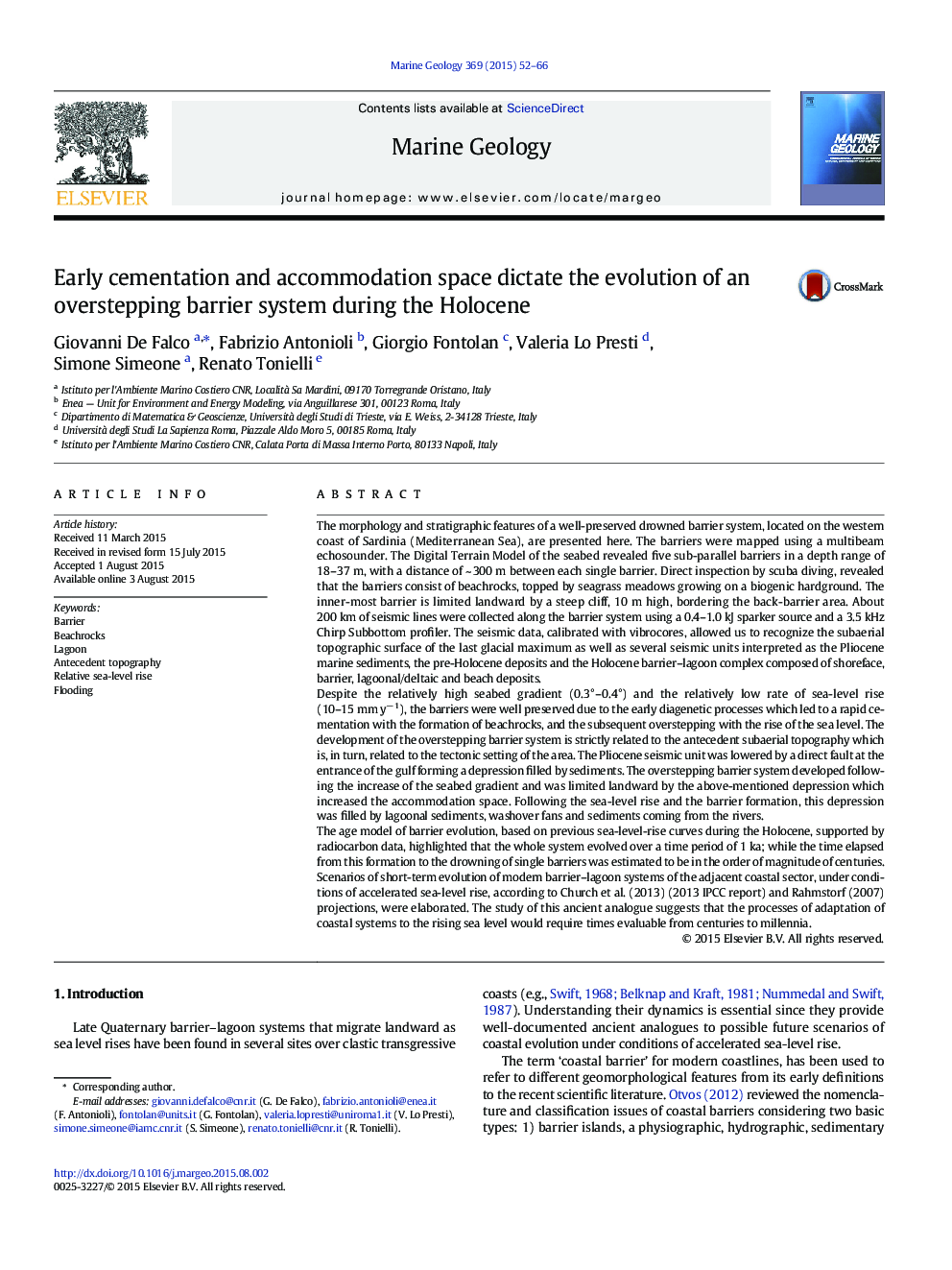| کد مقاله | کد نشریه | سال انتشار | مقاله انگلیسی | نسخه تمام متن |
|---|---|---|---|---|
| 4718175 | 1639083 | 2015 | 15 صفحه PDF | دانلود رایگان |
• Five parallel and aligned beachrocks at 18–37 m depth were mapped.
• These form a barrier–lagoon system with washover, lagoon and beach deposits.
• The system developed over a sloped seabed with a low sea-level rise rate over 1 ka.
• Early diagenesis and antecedent topography controlled the evolution of the system.
The morphology and stratigraphic features of a well-preserved drowned barrier system, located on the western coast of Sardinia (Mediterranean Sea), are presented here. The barriers were mapped using a multibeam echosounder. The Digital Terrain Model of the seabed revealed five sub-parallel barriers in a depth range of 18–37 m, with a distance of ~ 300 m between each single barrier. Direct inspection by scuba diving, revealed that the barriers consist of beachrocks, topped by seagrass meadows growing on a biogenic hardground. The inner-most barrier is limited landward by a steep cliff, 10 m high, bordering the back-barrier area. About 200 km of seismic lines were collected along the barrier system using a 0.4–1.0 kJ sparker source and a 3.5 kHz Chirp Subbottom profiler. The seismic data, calibrated with vibrocores, allowed us to recognize the subaerial topographic surface of the last glacial maximum as well as several seismic units interpreted as the Pliocene marine sediments, the pre-Holocene deposits and the Holocene barrier–lagoon complex composed of shoreface, barrier, lagoonal/deltaic and beach deposits.Despite the relatively high seabed gradient (0.3°–0.4°) and the relatively low rate of sea-level rise (10–15 mm y− 1), the barriers were well preserved due to the early diagenetic processes which led to a rapid cementation with the formation of beachrocks, and the subsequent overstepping with the rise of the sea level. The development of the overstepping barrier system is strictly related to the antecedent subaerial topography which is, in turn, related to the tectonic setting of the area. The Pliocene seismic unit was lowered by a direct fault at the entrance of the gulf forming a depression filled by sediments. The overstepping barrier system developed following the increase of the seabed gradient and was limited landward by the above-mentioned depression which increased the accommodation space. Following the sea-level rise and the barrier formation, this depression was filled by lagoonal sediments, washover fans and sediments coming from the rivers.The age model of barrier evolution, based on previous sea-level-rise curves during the Holocene, supported by radiocarbon data, highlighted that the whole system evolved over a time period of 1 ka; while the time elapsed from this formation to the drowning of single barriers was estimated to be in the order of magnitude of centuries.Scenarios of short-term evolution of modern barrier–lagoon systems of the adjacent coastal sector, under conditions of accelerated sea-level rise, according to Church et al. (2013) (2013 IPCC report) and Rahmstorf (2007) projections, were elaborated. The study of this ancient analogue suggests that the processes of adaptation of coastal systems to the rising sea level would require times evaluable from centuries to millennia.
Journal: Marine Geology - Volume 369, 1 November 2015, Pages 52–66
